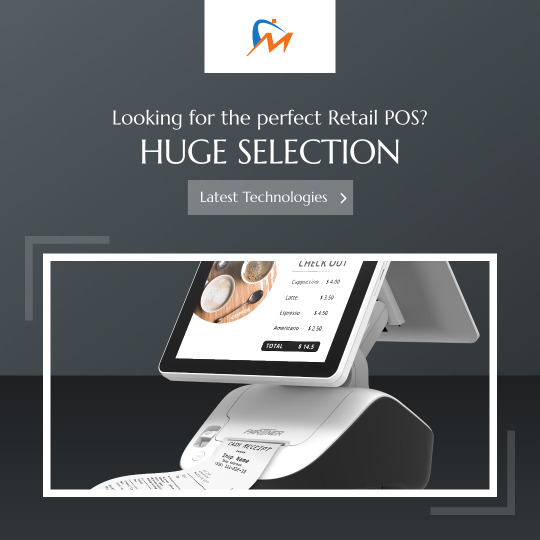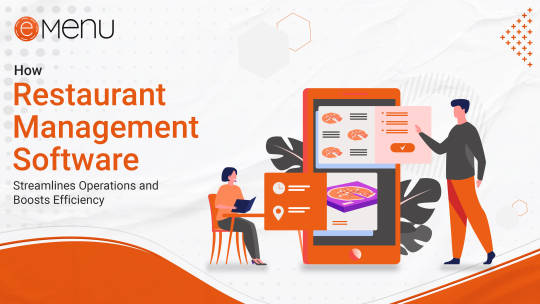#point of sales software
Text
Trends and Innovations in Point of Sale Software
Point of Sale (POS) software continues to evolve rapidly, driven by advancements in technology, changing consumer behaviors, and the evolving needs of businesses. As the retail landscape undergoes transformation, POS software adapts to meet new challenges and opportunities. In this article, we will explore the latest trends and innovations in POS software that are shaping the future of retail.
Cloud-Based POS Systems:
One of the most significant trends in POS software is the adoption of cloud-based solutions. Cloud POS systems offer several advantages over traditional on-premises software, including scalability, accessibility, and cost-effectiveness. With cloud-based POS, retailers can access their data from anywhere with an internet connection, enabling real-time inventory management, remote monitoring, and seamless integration with other business systems.
Mobile POS Solutions:
The proliferation of smartphones and tablets has led to the rise of mobile POS solutions. These lightweight and portable devices transform smartphones and tablets into powerful POS terminals, allowing businesses to process transactions anywhere within the store or even outside the traditional brick-and-mortar environment. Mobile POS solutions enhance flexibility, reduce checkout times, and enable personalized customer interactions, driving efficiency and improving the overall shopping experience.
Integration with E-commerce Platforms:
As e-commerce continues to grow, Point of Sales software is increasingly integrating with online shopping platforms to provide a seamless omnichannel experience. Integration with e-commerce platforms allows retailers to synchronize inventory, pricing, and customer data across online and offline channels, enabling customers to shop seamlessly across multiple touchpoints. This integration streamlines operations, enhances inventory management, and fosters customer loyalty by offering consistent and cohesive shopping experiences.
Artificial Intelligence and Machine Learning:
Artificial intelligence (AI) and machine learning are revolutionizing POS software by enabling advanced analytics, predictive insights, and personalized recommendations. AI-powered POS systems analyze vast amounts of transaction data to identify patterns, trends, and opportunities for optimization. By leveraging AI-driven insights, retailers can optimize pricing strategies, forecast demand more accurately, and personalize marketing campaigns to target specific customer segments effectively.
Contactless and Mobile Payments:
The COVID-19 pandemic has accelerated the adoption of contactless and mobile payment technologies, prompting POS software vendors to integrate support for these payment methods. Contactless payments, including Near Field Communication (NFC) and mobile wallets, offer convenience, speed, and enhanced security, reducing the need for physical contact during transactions. POS software that supports contactless and mobile payments enables retailers to cater to changing consumer preferences and adapt to the evolving payment landscape.
Enhanced Security Features:
With the increasing frequency and sophistication of cyber threats, POS software vendors are prioritizing security features to protect sensitive customer data and prevent data breaches. Modern POS systems incorporate advanced encryption techniques, tokenization, and biometric authentication to safeguard payment transactions and customer information. Additionally, compliance with industry standards such as PCI DSS (Payment Card Industry Data Security Standard) ensures that POS software meets stringent security requirements and provides peace of mind for retailers and customers alike.
Customization and Personalization:
Personalization is becoming increasingly important in retail, and POS software is no exception. Modern POS systems offer customization options that allow retailers to tailor the user interface, receipt formatting, and loyalty programs to reflect their brand identity and meet specific business needs. Furthermore, POS software can capture and analyze customer data to deliver personalized promotions, recommendations, and offers, enhancing customer engagement and driving repeat business.
Conclusion:
The evolution of POS software continues to drive innovation and transformation in the retail industry. From cloud-based solutions and mobile POS terminals to AI-driven analytics and contactless payments, modern POS systems are equipped with advanced features that empower retailers to adapt to changing consumer preferences, streamline operations, and enhance the overall shopping experience. By staying abreast of the latest trends and innovations in POS software, retailers can leverage technology to stay competitive and thrive in today's dynamic retail landscape.
0 notes
Text
Point of Sale Systems in Retail
#Point of Sale Systems in Retail#point of sale#point of sale system#retail#point of sale software#retail point of sale#pos system#retail pos system#best point of sale system#best retail pos system#point of sales software#best point of sale#market point of sale#best retail point of sale#grocery point of sale#health foods store point of sale#best retail point of sale software#point of sale software for retail store#best pos system for retail#point of sale (software genre)
1 note
·
View note
Text
Best POS Software in Bangladesh with Sales, Billing, and Inventory Management that helps retailers to manage the business with the best Point of Sales Software features.
#Point of Sales Software#POS software in Bangladesh#Retail POS Software#Sales Management Software#Inventory Management Software#POS software for Superstore management#Shop Management Software
0 notes
Text

Who's ready for our next training session?! 🙋♂️ You may have seen the wrap-up post about our recent Mitchell 1 Manager SE Shop Management Workshop, but are you curious what it was all about? Check out this press release as we share topics of discussion covered in the classes, the hands-on training provided, and what our team has to say!
🔗 https://www.m1repair.com/mitchell1-managerse-hosts-sold-out-shop-management-workshop-in-sd
Not able to make it to the workshop? GET STARTED NOW with a 14 day free trial of Mitchell 1 Manager SE and get LIVE training from your local Mitchell 1 Representative. No obligation. No credit card. No risk. It's 100% FREE!
#mitchell1#mitchell 1#manager se#shop management#shop management software#auto repair#automotive#car repair#point of sale#estimating#invoicing#workshop#training
2 notes
·
View notes
Text

Explore MTPOS System first – your go-to for professional, modern, and cost-effective Point of Sale solutions catering to both Small Businesses and Enterprises. Don't miss out, visit our website now!
2 notes
·
View notes
Text
Taking Stock: The Essentials of Restaurant Inventory Management Software

In the realm of gastronomy, where patrons demand nothing less than top-tier cuisine and impeccable service, restaurant proprietors and administrators face the arduous task of maintaining a well-stocked kitchen, minimizing wastefulness, and effectively managing expenditures. This is precisely where the realm of restaurant inventory management software comes into play. In this extensive discourse, we embark on a profound exploration of the fundamentals surrounding restaurant inventory management software, accentuating its merits, pivotal attributes, and the transformative potential it harbors for restaurant operations.
What Constitutes Restaurant Inventory Management Software?
Restaurant inventory management software stands as a formidable tool meticulously engineered to empower restaurant proprietors and supervisors in their relentless pursuit of methodically overseeing, tracking, and mastering their inventory infrastructure. It proffers a digital remedy to the timeless quandaries tied to the meticulous surveillance of ingredients, provisions, and equipment. This software forms the bedrock of a meticulously organized culinary haven, perpetually ensuring the harmonious rhythm of all operations.
The Merits of Adhering to Inventory Management Software
Meticulous Expenditure Oversight
Amongst the most noteworthy advantages attributed to restaurant inventory management software is its capacity to exercise judicious expenditure control. Through precise monitoring of inventory levels and the vigilant observation of consumption patterns, avenues for curbing extravagance and trimming expenses are unveiled. The ramifications of this could be profound, bearing the potential to elevate profitability to unprecedented heights.
Augmented Precision
Manual inventory management bears the inherent vulnerability of yielding inaccuracies, a potential source of stock-related discrepancies. The advent of inventory management software dispels this risk through the mechanization of the entire process. It endows you with real-time data, perpetually ensuring the pristine precision of your inventory records.
Amplified Efficiency
Efficiency is the quintessential cornerstone upon which any prosperous restaurant establishment is erected. Inventory management software expedites the ordering procedures by triggering alerts when inventory dwindles perilously low. This precludes the peril of overstocking or the harrowing scenario of crucial ingredients vanishing from your inventory, safeguarding the seamless operation of your kitchen.
The Pivotal Attributes of Restaurant Inventory Management Software
To surge past competitors within the fiercely competitive restaurant landscape, a keen comprehension of the cardinal attributes rendering inventory management software indispensable is imperative:
Inventory Surveillance - At its core, inventory management software is the sentinel of your inventory realm. It furnishes you with the means to vigilantly monitor the quantity and utilization of each constituent in real time. A mere glance suffices to discern which items teeter on the precipice of depletion, necessitating prompt replenishment.
Astute Supplier Management - Effective supplier management assumes a pivotal role in the flourishing of any dining establishment. Inventory management software empowers you to maintain meticulous records of your suppliers, encompassing their contact details and pricing specifics. Some advanced iterations even facilitate the automation of reordering contingent on predetermined criteria.
Integration with Culinary Repertoire - Seamless integration with your restaurant's menu constitutes a game-changing facet. It ensures that you perpetually possess the necessary ingredients to conjure each culinary masterpiece. Additionally, it provides insights into the most financially rewarding items on your menu.
The Prudent Selection of Restaurant Inventory Management Software
The task of selecting the apt software solution for your dining establishment is a decision of paramount importance, one that warrants meticulous deliberation. Here are some sagacious pointers to steer you toward an informed decision:
Discern Your Precise Requisites
Before embarking on your quest, undertake a comprehensive assessment of your restaurant's unique requirements. Contemplate factors such as the scale of your establishment, the intricacies of your culinary repertoire, and your fiscal constraints. Such self-awareness will function as the compass guiding you through your selection process.
2. Embrace a User-Friendly Interface
Opt for software that boasts an intuitive interface. Your staff should be able to acclimate themselves to it effortlessly, sans the need for extensive training endeavors. A user-friendly interface will not only conserve time but also stave off the specter of inadvertent errors.
3. Seamless Integration Capabilities
In instances where you are already availing yourself of other restaurant management software solutions, ascertain that your inventory system possesses the seamless integration capability essential for harmonious coexistence. Integration simplifies your operational workflow and obviates the redundancy of effort.
In Denouement
Inventory management with point of sale restaurant software appears as a hidden catalyst with the potential to propel your dining establishment to previously undiscovered levels of excellence. It is an important asset for any restaurateur or manager because of its ability to control expenses, improve precision, increase productivity, and provide invaluable data insights. You gain a competitive advantage in the frenetic world of gastronomy by meticulously handpicking software that matches your specific needs.
#inventory management#restaurant inventory management software#restaurant management software#restaurant point of sale#full service restaurant#kitchen display system#restaurant kds#online ordering system#restaurant pos system#self service kiosk
2 notes
·
View notes
Text
The Role of POS Software in Enhancing Customer Experience at Restaurants.

In the ever-evolving world of restaurants, providing an exceptional customer experience is crucial for success. From delectable cuisine to warm hospitality, every aspect counts. One significant factor that often goes unnoticed is the role of Point of Sale (POS) software in enhancing the overall customer experience. In this blog post, we will explore how POS software has revolutionized the restaurant industry and why it is indispensable for creating a seamless and satisfying dining experience.
Streamlined Ordering Process:
POS Software has revolutionized the way orders are taken and processed in restaurants. Gone are the days of manual order-taking, which often led to errors and delays. With the introduction of POS systems, servers can now quickly and accurately take orders directly at the table, transmitting them instantly to the kitchen. This streamlined process minimizes the chances of mistakes and ensures prompt service, allowing customers to enjoy their meals without unnecessary waiting times.
Personalized Service:
Another crucial aspect of enhancing the customer experience is personalization. OnlineEMenu POS Software enables restaurants to store detailed customer information, including preferences, dietary restrictions, and previous orders. With this data readily available, staff can provide a personalized dining experience tailored to individual tastes. From suggesting favorite dishes to accommodating special requests, the ability to remember customer preferences enhances customer satisfaction and fosters loyalty. OnlineEMenu POS Systems also facilitate effective customer relationship management by allowing targeted marketing campaigns and loyalty programs based on customer data.
Efficient Payment Options:
The payment process can often be a bottleneck in a restaurant's operations, leading to frustration for both customers and staff. POS software offers efficient payment options that simplify transactions, saving time and effort. Modern POS systems support various payment methods, including credit cards, mobile payments, and even cryptocurrencies. By offering a wide range of payment options, restaurants cater to customers' preferences and create a seamless payment experience. Additionally, integrated POS systems can split bills, apply discounts, and manage gratuities automatically, ensuring accuracy and eliminating the need for manual calculations.
Real-Time Inventory Management:
POS software goes beyond just facilitating transactions; it also plays a vital role in Inventory Management System. By keeping track of ingredient quantities and real-time sales data, restaurants can optimize their inventory levels and avoid stockouts or wastage. Efficient inventory management leads to smoother operations, ensuring that customers are not disappointed by unavailable menu items. Moreover, POS systems can generate automatic alerts when certain items reach low stock levels, enabling proactive ordering and maintaining a consistent dining experience.
Insightful Reporting and Analytics:
POS software offers valuable reporting and analytics capabilities, providing restaurant owners and managers with crucial insights into their business performance. Detailed reports on sales, customer preferences, peak hours, and more enable data-driven decision-making. These insights allow restaurants to identify trends, evaluate the success of menu items, and adjust pricing strategies accordingly. By leveraging the power of data, restaurants can continually enhance the customer experience, addressing any shortcomings and meeting evolving demands.
Conclusion:
In today's competitive restaurant industry, delivering an exceptional customer experience is essential for success. POS software has emerged as a game-changer, revolutionizing the way restaurants operate. From streamlined ordering and personalized service to efficient payments and insightful analytics, POS Systems empower restaurants to provide a seamless and satisfying dining experience. Embracing the power of technology through POS software not only enhances customer satisfaction but also improves operational efficiency, leading to increased profitability. As restaurants continue to adapt to changing consumer expectations, POS software remains an indispensable tool for delivering exceptional dining experiences.
youtube
#restaurant management software#restaurant pos system#restaurant management system#pos billing software#pos system#pos software#restaurant pos software#point of sale system#point of sale (pos) system#OnlineEMenu#point of sale#restaurant software#restaurant#restaurant billing software#restaurant point of sale#restaurant sales#restaurant ordering system#restaurant business#Youtube
5 notes
·
View notes
Text
How to Run a Restaurant Business Successfully in India: Essential Tips and Strategies
A thorough understanding of the Indian food sector, effective administration, and careful planning are all necessary for operating a successful restaurant. With the ever-increasing competition and evolving customer preferences, restaurant owners must stay ahead of the game to thrive in this dynamic market. In this article, we will explore essential tips and strategies for running a restaurant business successfully in India, with a particular focus on leveraging restaurant system management and software for efficient operations.
Embrace Technology: Restaurant Point of Sale (POS) Systems-
One of the most crucial aspects of running a successful restaurant business is adopting modern technology to streamline operations. A robust restaurant Point of sales system is an invaluable tool that can revolutionize your restaurant's efficiency and profitability. A restaurant POS system automates various tasks such as order management, inventory tracking, billing, and reporting.
Investing in reliable software for restaurant POS in India can enhance the overall dining experience for your customers. With a feature-rich POS system, you can expedite order processing, reduce errors, and improve table turnover. Furthermore, advanced POS software allows you to manage multiple aspects of your restaurant, including online orders, delivery, and reservations.
Optimize Restaurant System Management
Efficient management of your restaurant system is crucial for smooth day-to-day operations. Here are some essential tips to consider:
a) Staff Training: Invest in comprehensive training programs to ensure your staff is well-equipped to handle various responsibilities. Properly trained employees can provide better customer service, handle busy periods efficiently, and effectively utilize the restaurant POS system.
b) Inventory Management: Implement a robust inventory management system to track ingredients, supplies, and equipment. Regularly monitor stock levels, streamline procurement processes, and reduce wastage to minimize costs.
c) Menu Engineering: Analyze your menu and identify the most popular dishes, as well as the least profitable ones. Optimize your menu by highlighting high-margin items and removing underperforming dishes. This strategic approach can significantly impact your revenue and customer satisfaction.
d) Streamline Operations: Look for areas where you can automate or streamline operations further. This could include implementing self-service kiosks for order placement, online reservation systems, or integrating your POS system with third-party delivery platforms.
Focus on Customer Experience
In the highly competitive restaurant industry, providing an exceptional customer experience is paramount. Happy customers become loyal patrons and often spread positive word-of-mouth, which is invaluable for your business. Here are some tips to enhance the customer experience:
a) Personalized Service: Train your staff to provide personalized attention to customers. Encourage them to engage in friendly conversations, remember regular customers' preferences, and offer recommendations based on individual tastes.
b) Speed and Efficiency: With the help of a restaurant POS system, streamline your order management process to ensure quick and accurate service. Reduce waiting times, expedite food preparation, and optimize the billing process to leave a lasting positive impression.
c) Online Presence: Leverage the power of digital platforms to connect with your customers. Maintain an informative and user-friendly website, regularly update your social media accounts, and actively engage with customer reviews and feedback.
d) Loyalty Programs: Implement a customer loyalty program to incentivize repeat visits. Offer discounts, freebies, or exclusive benefits to encourage customers to choose your restaurant over competitors.
Maintain Quality and Consistency
Consistency is key to building a strong brand reputation and earning customer loyalty. To maintain high-quality standards:
a) Ingredients and Sourcing: Source fresh and high-quality ingredients from reliable suppliers. Ensure your kitchen staff follows strict guidelines for food preparation and storage.
b) Menu Testing: Regularly evaluate and test new dishes or menu updates to maintain consistency in taste, presentation, and portion sizes.
c) Hygiene and Cleanliness: Ensure that your restaurant maintains impeccable hygiene standards. Regularly clean and sanitize all areas, including the dining area, kitchen, restrooms, and storage spaces. Train your staff on proper food handling and safety practices to prevent any health hazards.
d) Feedback and Improvement: Encourage customer feedback and take it seriously. Address any concerns or complaints promptly and take necessary measures to rectify them. Use feedback as an opportunity for continuous improvement and to meet and exceed customer expectations.
Effective Marketing and Promotion
Implementing effective marketing and promotional strategies can help increase your restaurant's visibility and attract new customers. Consider the following tips:
a) Online Presence: Develop a strong online presence through a well-designed website, active social media profiles, and online review platforms. Regularly update your online platforms with enticing content, attractive food photography, and engaging promotions.
b) Local Partnerships: Collaborate with local influencers, food bloggers, and organizations to reach a wider audience. Offer special deals or partnerships to enhance visibility and credibility.
c) Special Events and Offers: Organize special events, themed nights, or seasonal promotions to create excitement and attract customers. Offer discounts, happy hour specials, or loyalty program incentives to entice new and repeat visitors.
d) Customer Referrals: Implement a referral program that rewards customers for bringing in new patrons. Word-of-mouth referrals can be highly effective in attracting new business.
Financial Management and Cost Control
To run a successful restaurant business, effective financial management is crucial. Consider these tips for better cost control:
a) Budgeting: Develop a comprehensive budget that includes all aspects of your restaurant's expenses, including food costs, staff salaries, rent, utilities, and marketing. Regularly review and analyze your budget to identify areas where costs can be reduced without compromising quality.
b) Menu Pricing: Set prices strategically by considering ingredient costs, competition, and customer perception. Ensure that your menu pricing allows for a healthy profit margin without alienating customers.
c) Vendor Negotiations: Build strong relationships with your suppliers and negotiate favorable terms to secure competitive pricing for ingredients and supplies. Regularly compare prices from different vendors to ensure you're getting the best deals.
d) Waste Reduction: Implement measures to minimize food waste and optimize portion sizes. Train your staff on portion control techniques and consider donating excess food to local charities or food banks.
Conclusion
Running a successful restaurant business in India requires a combination of effective management strategies, embracing technology, providing exceptional customer experiences, and implementing smart marketing techniques. By utilizing restaurant system management and leveraging pos restaurant software in India, you can streamline operations, enhance efficiency, and improve overall profitability. Additionally, focusing on customer satisfaction, maintaining quality standards, and controlling costs are essential elements of a thriving restaurant business. With dedication, continuous improvement, and the implementation of these essential tips and strategies, you can position your restaurant for success in the dynamic Indian food industry.

2 notes
·
View notes
Text











we are website development company wagzus.com, we are offering free website,logo,letter head, business card, broucher, marketing seo on just ordering of our product https://www.fiverr.com/s/QvoXoe in 5$.
#point of sale system#website design#website development#website developers#pos system#pos software#pos solutions#restaurant pos system#retail pos system#logo design#graphic design#leaflet#wordpress#wordpress themes#custom wordpress development#shopify#ecommerce#woocommerce#youtube thumbnail
5 notes
·
View notes
Text
Tens of thousands of people have been fired in the tech sector in the last six months alone. With the economy the way it is, and with people who are already unable to get a job, I wonder how an extra 20,000+ jobseekers are going to have any luck finding work.
#i just want to point out that this isn't just automation. it's different for every company but a lot of it comes down to profiteering imo#the video game industry made disgusting amounts of money during the pandemic. best three years of sales in history#but that momentum was never going to keep up forever. even when the momentum was at full swing people were getting laid off#Activision-Blizzard laid off over a hundred people just before christmas while bobby kotick got a $250 million bonus#thst might have even been before the pandemic#but you're seeing it with microsoft and ubisoft. wouldn't surprise me if sony and nintendo were following suit in a less public manner#microsoft - arguably the biggest tech conglomerate in the world (next to tencent) - laid off 10 thousand workers alone#i live in a town with just over 10 thousand people. in my entire fucking town. in my perspective that's more or less the world around me#all of those people - jobless#facebook - didn't like 7k people just get fired? that's hot on the heels of john carmack leaving too#john carmack is probably one of the top 100 people in the tech industry. his tech improvements helped aging PC hardware keep up for years#DOOM might be a meme but it ran that well because id software under john carmack revolutionised rendering techniques and scrolling#and stuff like that. john carmack has been at the forefront of graphical technology and game development for 30+ years#that's resulted in a couple duds like RAGE. he was also all-in on voxel technology before he moved into VR#all of that was context for this: john carmack left meta (who bought oculus) and lambasted the company for poor management on the way out#saying that he'd never seen such unnecessary and wanton expenditure in his career. meta were throwing their money at things thay don't work#here's john carmack trying to lay the groundwork of a successful game for meta's metaverse. here's meta chasing superfluous buzzwords#meta spent almost $14 BILLION on buzzwords and marketing at the behest of the actual tech. and then they FIRED 7000 PEOPLE!!!!!!#they had a HAIL MARY working on their game - because metaverse IS A GAME - and they prioritised SELLING THE PRODUCT BEFORE BUILDING IT#IT COST THEM $14 BILLION + THEIR HAIL MARY - AND THEN THEY FIRED THOUSANDS OF PEOPLE!!!!!!#Ubisoft and Activision-Blizzard have been facing mass resignations after years of abusive and toxic workplaces#and on top of that they're firing people too. google stadia just went under. it wouldn't surprise me if 2k and rockstar were firing people#I don't know how many other unemployed people there are in america - hundreds of thousands? but 20k more is even worse for everyone#keep in mind that even with a $14 billion loss - meta still makes billions. Microsoft is in no financial danger#tech is more lucrative now than ever. i genuinely believe that these cuts are to keep record profits at record heights#because the pandemic boom is ending and their ALREADY OBSCENELY LUCRATIVE revenue flows are going back to normal#so 20k+ tech workers are losing their jobs to keep $80 billion instead of $79 billion. all of those people - jobless#that's 20 thousand people with individual lives and families and expenses. lost their jobs in the last six months#that example i gave - $80 billion instead of $79 billion. that's not revenue. that's profit.#all of those people out of work due to incompetence at best and rank orofiteering at worst. their salaries and benefits come under revenue
4 notes
·
View notes
Text
Top 5 ways to increase Restaurant Profit

Establishing and making a restaurant profitable is a very challenging job nowadays, the restaurant market is facing tough competition. To make a restaurant profitable requires a combination of careful planning, marketing, and execution. Here are the 5 magical ways that will help you to increase your restaurant’s profits by 3X, they are -
Enhance Customer Experience
The first and foremost way to increase profit in a restaurant is to enhance customer experience. A good dining experience leaves a lasting impression on customers, leading them to come back again and again. To create an exceptional customer experience, make sure to offer quality food and drinks, friendly service, and a clean and welcoming atmosphere. Utilize technology to provide a seamless experience for customers, including digital menu, online ordering, and mobile payment options.
To improve customer satisfaction, you can offer loyalty programs, discounts and special promotions, or even implement a feedback system where customers can provide suggestions for improvements. Consider conducting surveys or focus groups to gather feedback and understand what customers like and dislike about their dining experience at your restaurant.
QR Code & Customer Loyalty Programs of Online eMenu may help you to provide a great experience to your customers, Online eMenu is India’s Fastest Growing restaurant software, offering 60% discount on its annual subscription, you may get it at just Rs 3999.
Optimize Menu
A well-crafted menu is essential for a profitable restaurant. You can maximize your profits by identifying the most popular menu items, the ones that have the highest profit margins, and the ones that are most frequently ordered. This information can be used to make informed decisions on pricing, portion sizes, and menu offerings.
Consider offering daily specials or seasonal menu items to keep customers engaged and interested in coming back. This will also allow you to take advantage of low-cost seasonal ingredients to increase profitability. Another option is to offer a limited menu that focuses on your most profitable items, rather than offering a wide range of options.
Online eMenu offers an attractive Digital Menu which is easy to edit and optimize. You may update your menu anytime with it.
Manage Inventory and Purchasing
Effective inventory management is critical to increasing restaurant profits. This involves tracking food and beverage costs, determining the ideal stock levels, and reducing waste. Restaurants can save money by negotiating better deals with suppliers, purchasing in bulk, and reducing spoilage.
You should also implement a purchasing system that ensures consistent purchasing practices and minimizes waste. This includes a regularly updated ordering guide, ordering from a preferred vendor list, and maintaining a minimum order amount to reduce shipping costs.
Inventory Management System of Online eMenu is the right choice to manage your inventory, Learn More
Streamline Operations
Streamlining your restaurant operations can help increase profits by reducing labor costs, waste, and inefficiencies. One way to do this is by automating tasks, such as ordering, scheduling, and tracking inventory. Another way is to implement an efficient kitchen layout and workflow to reduce wait times and increase kitchen productivity.
Additionally, investing in energy-efficient equipment and lighting can help reduce energy costs and increase profitability. Finally, providing regular training for employees and setting clear performance expectations can help ensure that everyone is working efficiently and effectively.
Online eMenu helps restaurants owners to cut the operation cost and helps to optimize the staff and other resources, enquire now to know more
Marketing and Promotion
A comprehensive marketing and promotion strategy can help increase restaurant profits by attracting new customers and retaining existing ones. Utilize social media and email marketing to reach customers, and offer discounts and promotions to incentivize them to visit your restaurant.
Participate in community events and partner with local businesses to increase visibility and reach new customers. You can also offer takeout and delivery options to make it easier for customers to enjoy your food from the comfort of their own homes. Finally, consider hosting special events, such as wine dinners or live music nights, to create a unique and memorable experience for customers.
Online eMenu comes with Integrated WhatsApp Marketing solutions including Readymade Social Media Posters, Readymade Promotional Posters, Scheduled Messaging, and Customer Data Management. Solve Marketing and Promotion for Your Restaurant with Online eMenu. Learn More
Online eMenu comes with Integrated WhatsApp Marketing solutions including Readymade Social Media Posters, Readymade Promotional Posters, Scheduled Messaging, and Customer Data Management. Solve Marketing and Promotion for Your Restaurant with Online eMenu. Learn More
2 notes
·
View notes
Text
Point of Sales Software: The Key to Retail Success
Point-of-sale (POS) software plays a crucial role in achieving retail success by providing numerous benefits that help streamline operations, enhance customer satisfaction, and drive profitability.
Firstly, Point-of-sale software enables retailers to efficiently manage inventory by accurately tracking stock levels, monitoring product performance, and automating replenishment processes. This ensures that retailers have the right products available at the right time, minimizing stockouts and improving customer satisfaction. With real-time inventory updates, retailers can also make data-driven decisions regarding pricing, promotions, and stocking strategies, optimizing their product offerings to meet customer demands and maximize sales.
Secondly, POS software enhances the customer experience by enabling seamless transactions and personalized interactions. It facilitates quick and efficient checkout processes, reducing wait times and improving customer satisfaction. Additionally, many POS systems integrate with customer relationship management (CRM) tools, allowing retailers to store customer information, purchase history, and preferences. This data empowers retailers to offer personalized recommendations, targeted promotions, and loyalty rewards, fostering stronger customer relationships and increasing customer retention.
Moreover, POS software often supports various payment options, including mobile payments and digital wallets, providing customers with convenient and flexible payment methods. These features collectively contribute to an improved customer experience, leading to higher customer satisfaction, increased loyalty, and ultimately, retail success.
0 notes
Text
Point of Sale Software in Retail
#Point of Sale Software in Retail#point of sale#point of sale software#best retail point of sale software#pos software#point of sale system#best point of sale software#best retail point of sale#retail software#point of sales software#retail#rain retail software#online point of sale#retail point of sale#best point of sale system#cloud based point of sale#point of sale (software genre)#retail pos software#retail point of sale software#top retail point of sale software
1 note
·
View note
Text
Extreme Solutions provides the best POS software in Bangladesh at an affordable price. Software features are sales, purchase, inventory, supplier, customer, barcode Generation Module, etc.
#Point of Sales Software#POS Software in Bangladesh#Shop Management Software#Sales & Inventory Software#Supershop Management Software#Inventory Management Software#Accounting Software in Bangladesh
1 note
·
View note
Text

Are you looking for the best Point of Sale Software in Saudi Arabia? Then, check out our pos software solutions! Contact us Now!
2 notes
·
View notes
Text
How Restaurant Management Software Streamlines Operations and Boosts Efficiency

The restaurant industry is highly competitive, and efficient operations play a crucial role in the success of any establishment. In today's digital age, restaurant management software has emerged as a powerful tool to streamline operations and boost efficiency. This blog post explores the various ways in which restaurant management software revolutionizes the way restaurants operate, enabling them to deliver exceptional customer experiences while optimizing their backend processes.
The Role of Restaurant Management Software:
Online eMenu Restaurant management software is a comprehensive solution designed to handle the diverse aspects of running a restaurant. It encompasses a wide range of features and functionalities that simplify day-to-day operations, enhance productivity, and improve overall efficiency. From Restaurant tasks to Restaurant operations, the software offers a centralized platform to manage and streamline various processes.
Streamlining Restaurant Operations:
In the bustling environment of a restaurant, managing Restaurant operations efficiently is essential. Online eMenu Restaurant management software offers tools for reservation and table management software, allowing customers to book tables online and providing staff with real-time updates on reservations. This helps optimize table turnover and maximize seating capacity, leading to better customer service and increased revenue. Additionally, the software integrates with the point-of-sale (POS) system, enabling seamless order taking and processing.
Enhancing Restaurant Efficiency:
Efficiency in the Restaurant operations is equally important for smooth restaurant functioning. With restaurant management software, staff scheduling and labor management become hassle-free. The software automates scheduling, taking into account factors such as staff availability and workload, resulting in optimized staff allocation and improved productivity. It also tracks labor costs and performance metrics, providing valuable insights for effective decision-making.
Supplier and procurement management is another critical aspect that software addresses. By streamlining the ordering process and managing suppliers, restaurants can ensure timely and accurate deliveries. The software facilitates inventory forecasting, minimizing wastage and optimizing stock levels. Real-time reporting and analytics capabilities empower restaurant owners and managers to monitor sales, expenses, and performance, enabling data-driven decision-making.
Customer Relationship Management (CRM):
Building strong customer relationships is vital for the success of any restaurant. Restaurant management software Customer Relationship Management (CRM) helps in creating and maintaining customer profiles, capturing preferences, and analyzing data to deliver personalized experiences. Additionally, the software facilitates the implementation of loyalty programs and targeted marketing campaigns, allowing restaurants to engage with customers effectively and increase customer retention.
Ensuring Data Security and Accessibility:
Data security is a paramount concern in today's digital landscape. Restaurant management software offers robust security measures to protect sensitive customer information and business data. Cloud-based solutions provide data backup and ensure accessibility from anywhere, anytime, allowing owners and managers to monitor and manage their restaurant's operations remotely. User access control features further enhance data privacy and confidentiality.
Case Studies: Success Stories of Restaurant Management Software Implementation
Real-life examples of restaurants that have implemented restaurant management software can provide valuable insights into its effectiveness. Case studies highlighting specific improvements and outcomes achieved through the software demonstrate how it has helped restaurants streamline their operations, enhance efficiency, and deliver exceptional dining experiences.
Challenges and Considerations:
While restaurant management software offers numerous benefits, it's essential to consider potential challenges and factors when selecting the right software. Factors such as cost, scalability, user-friendliness, and integration capabilities with existing systems should be evaluated before making a decision. Addressing these considerations ensures a successful implementation and maximizes the software's potential.
Conclusion:
Restaurant Management software has become a game-changer in the industry, revolutionizing the way restaurants operate. By streamlining operations, enhancing efficiency, and optimizing processes, this software empowers restaurants to deliver exceptional customer experiences while driving profitability. As technology continues to shape the future of the restaurant industry, embracing restaurant management software becomes essential for those seeking.
#restaurant management software#contactless menu system#qr code#restaurant management system#restaurant pos system#contactless menu#contactless qr code menu#contactless ordering app#point-of-sale (POS) system#point-of-sale system#pos billing software#restaurant pos software#pos system#pos software#restaurant software#restaurant sales#restaurant#qrcodemenu#qr code menu#cloud based pos billing system#cloud based pos billing software#crm software#crmintegration#restaurant crm#restaurant crm software#crm development#online food ordering software#online food ordering system#food ordering system online#Restaurant Table Booking
4 notes
·
View notes